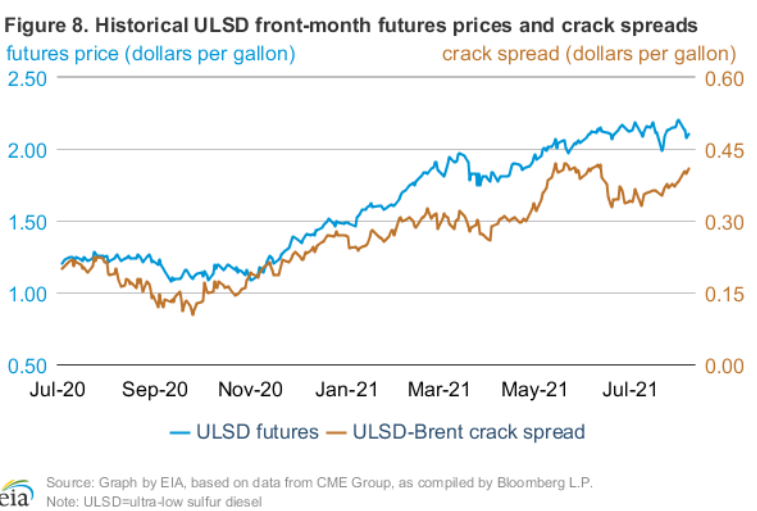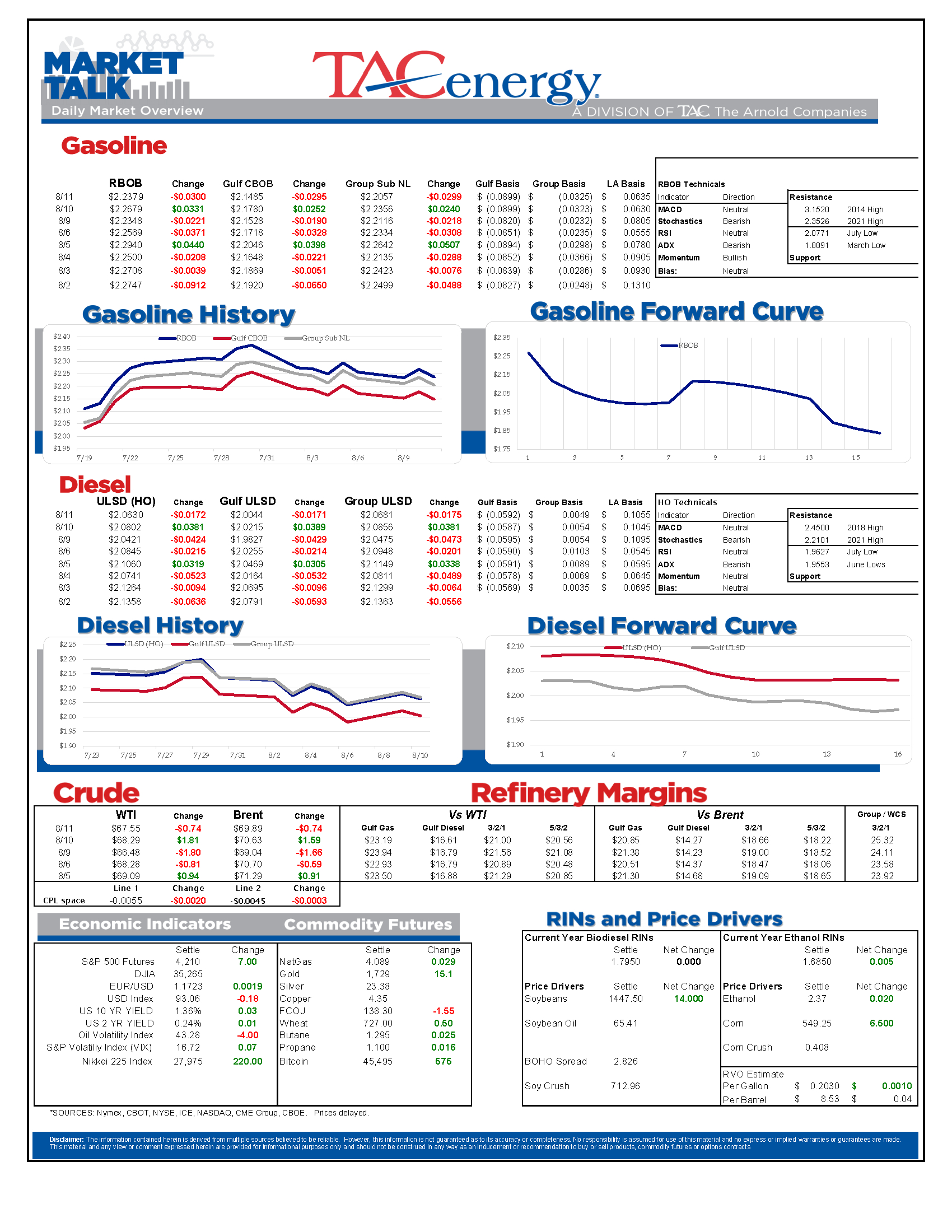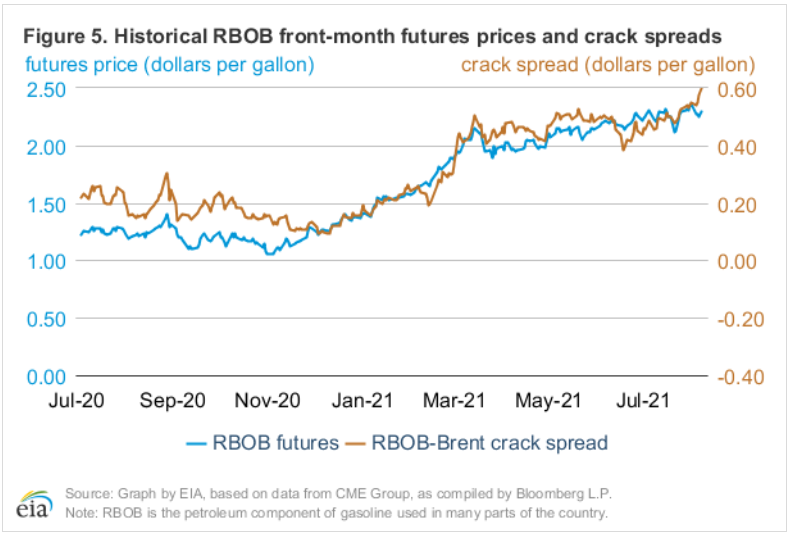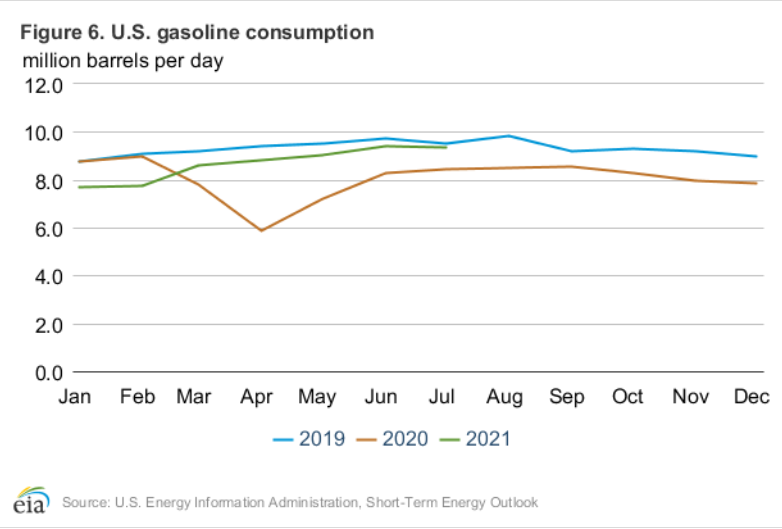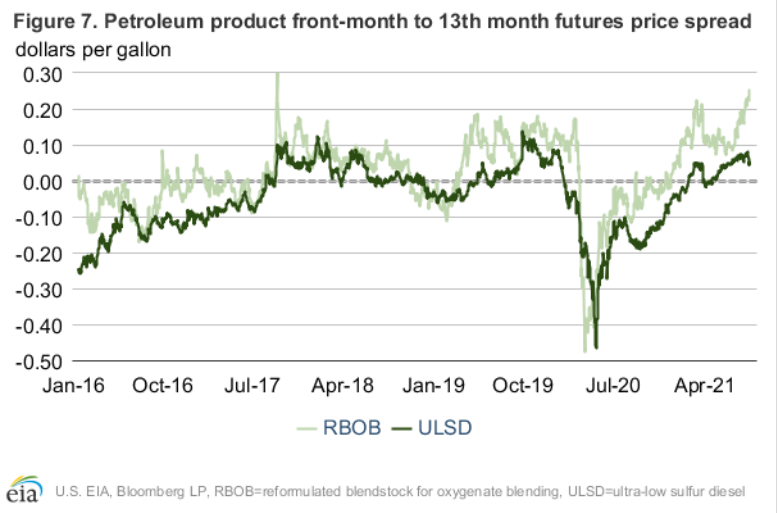Whiplash Is The Theme This Week

Whiplash is the theme this week, as refined products have their 3rd straight nickel swing in the early going, wiping out most of Tuesday’s gains…which wiped out most of Monday’s losses. The pullback keeps the August trend-lines pointing down, with lower highs set in each subsequent bounce suggesting more selling to come unless the bulls manage to break back above the July highs.
A major difference in today’s selling is that rising COVID cases aren’t taking the blame for the selling, instead a report that the White House is pressuring OPEC & Friends to produce more oil and help tame prices is getting credit for the selloff.
At face value that doesn’t seem to help explain why gasoline is leading the slide, but the report also suggests the white house is going to push the federal trade commission to take a look at rising gasoline prices. That investigation doesn’t need much effort to see the inconvenient truth that the RFS, LCFS and Cap & Trade programs each add more than 20 cents/gallon to fuel prices, and by design will get costlier each year. Then again, blaming climate change programs for rising prices won’t win many points in Washington, and it will be easier to blame refiners, which could complicate some of the acquisitions currently in process.
After several big moves in the past 2 weeks, West Coast basis values cooled off Tuesday, but could see more buying pressure today if the latest in a string of refinery hiccups disrupts one of the last refineries standing in the SF Bay area.
You think prices are volatile now? Read this WSJ article on the tough decisions retail stations have to make in regards to EV charging stations, one of which is having to guess at what their electricity costs will be. Those retail stations did score a major victory this week when the new infrastructure bill prevented interstate rest-stops from installing EV chargers, which would have put utilities in a position to directly compete with those stations, using federal property in many cases.
The EIA’s Short Term Energy Outlook seemed to offer a bullish boost to prices Tuesday, as the agency’s contracted thinkers at IHS increased their gasoline demand estimates, and lowered their OPEC oil output forecasts. The report highlighted how both calendar and crack spreads for gasoline have reached multi-year highs as inventories have rapidly drawn down in recent months. Once again, the report fails to mention the influence of RIN values on those gasoline prices, which knock about $8.5/barrel (~20 cents/gallon) off of those crack spreads.
The API’s weekly report looks like it was largely shrugged off, with only minimal changes in inventory reported. Crude stocks were said to be down 816k barrels, gasoline was down 1.1 million and distillates built 673k. The EIA’s version of the stats are scheduled to be out at their normal time this morning.
Click here to download a PDF of today's TACenergy Market Talk.
Latest Posts
Energy Markets Rally Again Thursday After A Choppy Wednesday Session
Week 16 - US DOE Inventory Recap
Energy Markets Trading Quietly In The Red As Ethanol Prices Rally To Five-Month High
The Struggle For Renewable Producers Continues As A Rapid Influx Of Supply And Crashing Credit Prices Make Biodiesel
Social Media
News & Views
View All
Energy Markets Rally Again Thursday After A Choppy Wednesday Session
Energy markets are trying to rally again Thursday after a choppy Wednesday session. RBOB gasoline futures are leading the push higher, on pace for a 3rd consecutive day of gains after finding a temporary floor Tuesday and have added 12 cents from those lows.
Equity markets are pointing sharply lower after a weak Q1 GDP estimate which seems to have contributed to a pullback in product prices over the past few minutes, but don’t be surprised if the “bad news is good news” low interest rate junkies start jumping in later on.
The DOE’s weekly report showed sluggish demand for gasoline and diesel, but inventory levels in most markets continue to follow their typical seasonal trends. Refinery runs held fairly steady last week with crude inputs down slightly but total gross throughputs up slightly as most facilities are now back online from a busy spring maintenance season and geared up for peak demand this summer.
Propane and propylene exports spiked to a record high north of 2.3 million barrels/day last week, which demonstrates both the US’s growing influence on global product markets, and the steady shift towards “other” products besides traditional gasoline and diesel in the level of importance for refiners.
The EIA acknowledged this morning that its weak diesel consumption estimates reflected the switch to Renewable Diesel on the West Coast, although they did not provide any timeline for when that data will be included in the weekly survey. The agency acknowledged that more than 4% of the total US consumption is now a combination of RD and Biodiesel, and that number is expected to continue to grow this year. This morning’s note also suggested that weak manufacturing activity was to blame for the sluggish diesel demand across the US, while other reports suggest the freight recession continued through Q1 of this year, which is also contributing to the big shift from tight diesel markets to oversupplied in several regions.
Valero kicked off the Q1 earnings releases for refiners with solid net income of $1.2 billion that’s a far cry from the spectacular earnings north of $3 billion in the first quarter of 2023. The refining sector made $1.7 billion, down from $4.1 billion last year. That is a pattern that should be expected from other refiners as well as the industry returns to a more normal market after 2 unbelievable years. You wouldn’t guess it by looking at stock prices for refiners though, as they continue to trade near record highs despite the more modest earnings.
Another pattern we’re likely to see continue with other refiners is that Renewable earnings were down, despite a big increase in production as lower subsidies like RINs and LCFS credit values sting producers that rely on those to compete with traditional products. Valero’s SAF conversion project at its Diamond Green joint venture is progressing ahead of schedule and will give the company optionality to flip between RD and SAF depending on how the economics of those two products shakes out this year. Valero also shows part of why refiners continue to disappear in California, with operating expenses for its West Coast segment nearly 2X that of the other regions it operates in.

Week 16 - US DOE Inventory Recap

Energy Markets Trading Quietly In The Red As Ethanol Prices Rally To Five-Month High
Energy markets are trading quietly in the red to start Wednesday’s session after a healthy bounce Tuesday afternoon suggested the Israel-Iran-linked liquidation had finally run its course.
There are reports of more Ukrainian strikes on Russian energy assets overnight, but the sources are sketchy so far, and the market doesn’t seem to be reacting as if this is legitimate news.
Ethanol prices have rallied to a 5-month high this week as corn and other grain prices have rallied after the latest crop progress update highlighted risks to farmers this year, lower grain export expectations from Ukraine, and the approval of E15 blends this summer despite the fact it pollutes more. The rally in grain and renewables prices has also helped RIN values find a bid after it looked like they were about to test their 4-year lows last week.
The API reported small changes in refined product inventories last week, with gasoline stocks down about 600,000, while distillates were up 724,000. Crude oil inventories increased by 3.2 million barrels according to the industry-group estimates. The DOE’s weekly report is due out at its normal time this morning.
Total reported another upset at its Port Arthur refinery that’s been a frequent flier on the TCEQ alerts since the January deep freeze knocked it offline and damaged multiple operating units. This latest upset seems minor as the un-named unit impacted was returned to normal operations in under an hour. Gulf Coast basis markets have shrugged off most reports of refinery upsets this year as the region remains well supplied, and it’s unlikely we’ll see any impact from this news.
California conversely reacted in a big way to reports of an upset at Chevron’s El Segundo refinery outside of LA, with CARBOB basis values jumping by more than a dime. Energy News Today continued to show its value by reporting the upset before the flaring notice was even reported to area regulators, proving once again it’s ahead of the curve on refinery-related events. Another industry news outlet meanwhile struggled just to remember where the country’s largest diesel seller is located.
Click here to download a PDF of today's TACenergy Market Talk
